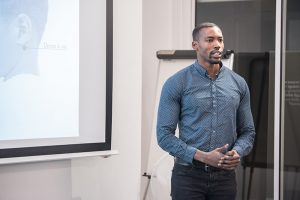
Each month we will be showcasing case studies on enterprise in education. This month we spoke to third year undergraduate, Rodrigo de Carvalho, who is studying product design at London South Bank University while he establishes a social enterprise dedicated to helping protect children at risk of abduction.
Rodrigo de Carvalho, 33-year-old Brazilian student moved to the UK in to study English a decade ago and spent some time working in events management and hospitality. However, in 2015 he decided to follow his passion and enrolled to study at LSBU. He says:
“My course, Product Design, is very broad covering everything from manufacturing and graphics to design thinking, coding and 3D… That gives me a lot of options after I graduate, although I am already moving towards app development and using design thinking to work on the user experience.”
Last year, Rodrigo and others on his course received a university brief that asked them to create ‘social change by design.’ In response, he has established social enterprise the Kindogo Project, an idea originally triggered when Rodrigo entered the Design Factory competition run by the Design Museum. He says:
“The university’s brief asked us to go to the Design of the Year exhibition at the Design Museum where most of the exhibits were about social change projects. As students we were each asked to select one of those projects as inspiration, developing work already done or solving new problems related to the issue.”
The project/exhibit Rodrigo had chosen at the Design Museum was a sanitation product designed for use in the developing world and was already very well designed. For this reason, the student kept the developing world as his starting point but took a little extra inspiration from a friend. He says:
“I decided to speak to a friend of mine who has a charity in Uganda called Kannana Interactive. He told me about some of the issues faced by children in Africa. Of course these are all over the news but I wanted to hear from him as he has the direct experience there. Of the many issues he mentioned, the one I connected with was about protecting children from abduction because I felt that there hasn’t been a major fight against this issue.”
Having heard about the plight of children under threat of kidnapping by terrorist organisations in Uganda, Rodrigo applied his product design skills to creating the Kindogo. The product began life as a simple low cost GPS tracking device built into a watch-like accessory which would allow the authorities to track children who had been abducted.
“I considered how GPS could help reduce the problem. Initially I thought the product could be given to the children as a watch with a solar panel, a GPS and nothing else.”
This relatively simple idea so impressed judges of the national Design Factory competition that Rodrigo was one of the 14 regional winners. However, he also received some great feedback on the design from one of the directors of the Design Museum. Rodrigo remembers what he said:
“The feedback pointed out that if you give a watch to a Ugandan child it’s not something familiar to the culture there. It will draw attention. Also, the original product had triggered a signal of danger if the watch strap was broken but children play and the strap could be broken accidently. The director prompted me to rethink these parts of the product’s design.”
In order to remedy the flaws in his design, Rodrigo undertook extra research and began to consult with professors in chemical engineering and telecommunications. Right now, the product is in a fresh prototype stage.
Having enjoyed such success with this ongoing project via the Design Museum’s competition, and keen to develop his idea, Rodrigo has accessed a number of LSBU enterprise schemes, all designed to encourage entrepreneurial activity. During the last academic year, he completed an optional, two-week enterprise module called ‘Bootcamp - How to develop my idea’ in order to apply business thinking to his unique product design idea. Most recently, he has joined LSBU’s six-month long Spark Programme, which is taught in weekly sessions. He says:
“The Spark programme has helped me to go more in-depth to develop my business and myself. It takes you through the stages of putting a business together and I’m learning a lot about how to create a business model, how to give your idea purpose, how to conduct market research and how to develop your product.”
Like many of the students who join the university’s Spark Programme, Rodrigo has also decided to try his hand at Pitch It. This LSBU initiative invites entrepreneurial students and recent graduates to present their ideas in order to secure a pot of money which they can then invest into their fledgling businesses or social enterprises. However, for Rodrigo one of the most rewarding aspects of the Spark Programme and Pitch It has been the way they bring together similarly minded, enterprising students. He says:
“What I like is the dynamic of the group and the way we can support each other as we build enterprises. One example of this is a girl who was brainstorming her branding. She put her logo choices up and people were helping, commenting on which would work. When you have a product Spark helps you get it ready to go to market.”
In fact, Rodrigo seems more than ready to introduce his design to the world and his hopes for the future are already taking shape:
“Hopefully the Kindogo Project will be a success. I have contact with organisations like UNICEF and the UN so once the final product is developed I will already be in a position to take it forward once I’ve graduated in June 2018. Until then I’m really enjoying studying at LSBU and I’m getting great support as a student entrepreneur.”


